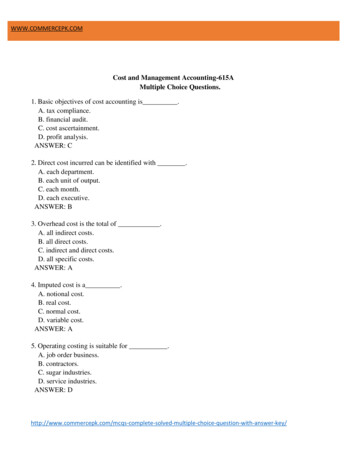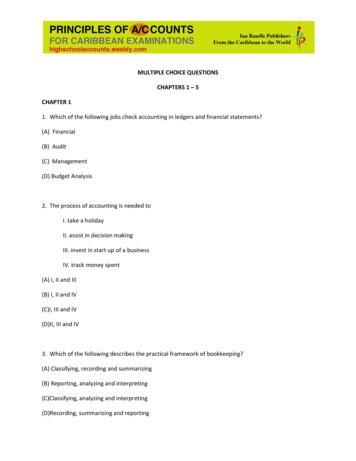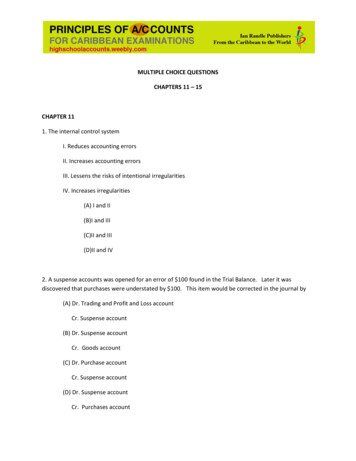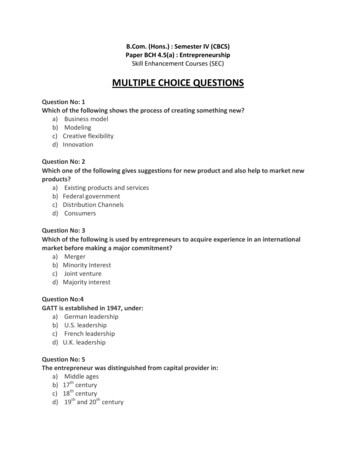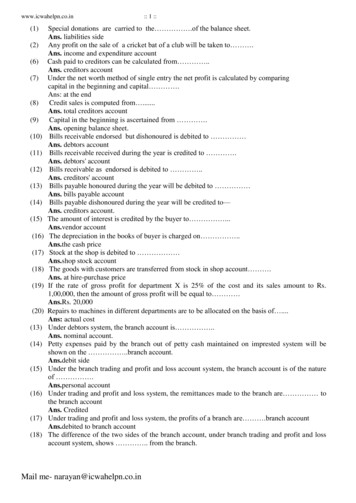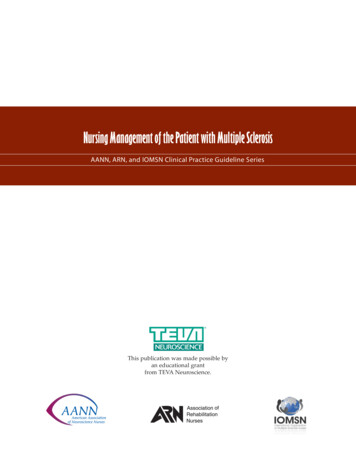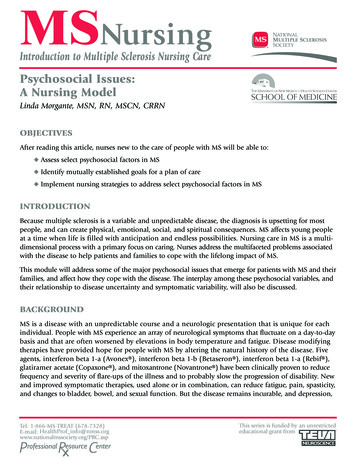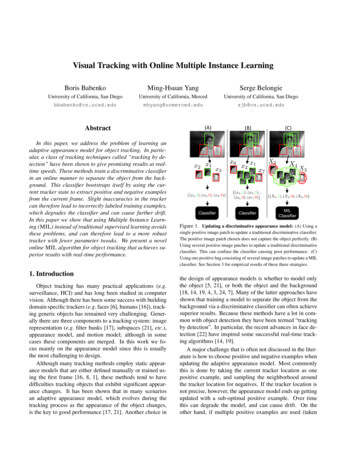
Transcription
Visual Tracking with Online Multiple Instance LearningBoris BabenkoMing-Hsuan YangSerge BelongieUniversity of California, San DiegoUniversity of California, MercedUniversity of California, San .ucsd.eduAbstractIn this paper, we address the problem of learning anadaptive appearance model for object tracking. In particular, a class of tracking techniques called “tracking by detection” have been shown to give promising results at realtime speeds. These methods train a discriminative classifierin an online manner to separate the object from the background. This classifier bootstraps itself by using the current tracker state to extract positive and negative examplesfrom the current frame. Slight inaccuracies in the trackercan therefore lead to incorrectly labeled training examples,which degrades the classifier and can cause further drift.In this paper we show that using Multiple Instance Learning (MIL) instead of traditional supervised learning avoidsthese problems, and can therefore lead to a more robusttracker with fewer parameter tweaks. We present a novelonline MIL algorithm for object tracking that achieves superior results with real-time performance.1. IntroductionObject tracking has many practical applications (e.g.surveillance, HCI) and has long been studied in computervision. Although there has been some success with buildingdomain specific trackers (e.g. faces [6], humans [16]), tracking generic objects has remained very challenging. Generally there are three components to a tracking system: imagerepresentation (e.g. filter banks [17], subspaces [21], etc.),appearance model, and motion model; although in somecases these components are merged. In this work we focus mainly on the appearance model since this is usuallythe most challenging to design.Although many tracking methods employ static appearance models that are either defined manually or trained using the first frame [16, 8, 1], these methods tend to havedifficulties tracking objects that exhibit significant appearance changes. It has been shown that in many scenariosan adaptive appearance model, which evolves during thetracking process as the appearance of the object changes,is the key to good performance [17, 21]. Another choice in(A)(B)(C)ClassifierClassifierMILClassifierFigure 1. Updating a discriminative appearance model: (A) Using asingle positive image patch to update a traditional discriminative classifier.The positive image patch chosen does not capture the object perfectly. (B)Using several positive image patches to update a traditional discriminativeclassifier. This can confuse the classifier causing poor performance. (C)Using one positive bag consisting of several image patches to update a MILclassifier. See Section 3 for empirical results of these three strategies.the design of appearance models is whether to model onlythe object [5, 21], or both the object and the background[18, 14, 19, 4, 3, 24, 7]. Many of the latter approaches haveshown that training a model to separate the object from thebackground via a discriminative classifier can often achievesuperior results. Because these methods have a lot in common with object detection they have been termed “trackingby detection”. In particular, the recent advances in face detection [22] have inspired some successful real-time tracking algorithms [14, 19].A major challenge that is often not discussed in the literature is how to choose positive and negative examples whenupdating the adaptive appearance model. Most commonlythis is done by taking the current tracker location as onepositive example, and sampling the neighborhood aroundthe tracker location for negatives. If the tracker location isnot precise, however, the appearance model ends up gettingupdated with a sub-optimal positive example. Over timethis can degrade the model, and can cause drift. On theother hand, if multiple positive examples are used (taken
Frame (t)Frame (t 1)Probability MapFrame (t 1)XXold locationnew locationMODELStep 1: UpdateAppearance Model3:MODELStep 2: Apply AppearanceModel inside of windowaround old locationAlgorithm 1 MILTrackInput: New video frame number k1: Crop out a set of image patches, X s {x s l(x) lt 1 } and compute feature vectors.s2: Use MIL classifier to estimate p(y 1 x) for x X .Stepp 3: UpdatepTracker StateFigure 2.Tracking by detection with a greedy motion model: anillustration of how most tracking by detection systems work.from a small neighborhood around the current tracker location), the model can become confused and its discriminative power can suffer (cf . Fig. 1 (A-B)). Alternatively,Grabner et al. [15] recently proposed a semi-supervised approach where labeled examples come from the first frameonly, and subsequent training examples are left unlabeled.This method is particularly well suited for scenarios wherethe object leaves the field of view completely, but it throwsaway a lot of useful information by not taking advantage ofthe problem domain (e.g., when it is safe to assume smallinterframe motion).Some of the above issues are encountered in object detection because it is difficult for a human labeler to beconsistent with respect to how the positive examples arecropped. In other words, the exact object locations are unknown. In fact, Viola et al. [23] argue that object detectionhas inherent ambiguities that make it more difficult to traina classifier using traditional methods. For this reason theysuggest the use of a Multiple Instance Learning (MIL) [9]approach for object detection. We give a more formal definition of MIL in Section 2.2, but the basic idea of this learning paradigm is that during training, examples are presentedin sets (often called “bags”), and labels are provided for thebags rather than individual instances. If a bag is labeled positive it is assumed to contain at least one positive instance,otherwise the bag is negative. For example, in the context ofobject detection, a positive bag could contain a few possiblebounding boxes around each labeled object (e.g. a humanlabeler clicks on the center of the object, and the algorithmcrops several rectangles around that point). Therefore, theambiguity is passed on to the learning algorithm, which nowhas to figure out which instance in each positive bag is themost “correct”. Although one could argue that this learningproblem is more difficult in the sense that less informationis provided to the learner, in some ways it is actually easierbecause the learner is allowed some flexibility in finding adecision boundary. Viola et al. present convincing resultsshowing that a face detector trained with weaker labeling(just the center of the face) and a MIL algorithm outperforms a state of the art supervised algorithm trained withexplicit bounding boxes.Update tracker location lt l argmaxx X s p(y x)Crop out two sets of image patches X r {x r l(x) lt } and X r,β {x β l(x) lt r}.5: Update MIL appearance model with one positive bagX r and X r,β negative bags, each containing a singleimage patch from the set X r,β4:In this paper we make an analogous argument to that ofViola et al. [23], and propose to use a MIL based appearance model for object tracking. In fact, in the object tracking domain there is even more ambiguity than in object detection because the tracker has no human input and has tobootstrap itself. Therefore, we expect the benefits of a MILapproach to be even more significant than in the object detection problem. In order to implement such a tracker, anonline MIL algorithm is required. The algorithm we propose is based on boosting and is related to the MILBoostalgorithm [23] as well as the Online-AdaBoost algorithm[20] (to our knowledge no other online MIL algorithm currently exists in the literature). We present empirical resultson challenging video sequences, which show that using anonline MIL based appearance model can lead to more robustand stable tracking than existing methods in the literature.2. Tracking with Online MILIn this section we introduce our tracking algorithm, MILTrack, which uses a MIL based appearance model. We begin with an overview of our tracking system which includesa description of the motion model we use. Next we reviewthe MIL problem and briefly describe the MILBoost algorithm [23]. We then review online boosting [20, 14] andpresent a novel boosting based algorithm for online MIL,which is required for real-time MIL based tracking. Finally,we review various implementation details.2.1. System Overview and Motion ModelThe basic flow of the tracking system we implementedin this work is illustrated in Fig. 2 and summarized in Algorithm 1. As we mentioned earlier, the system contains threecomponents: image representation, appearance model andmotion model. Our image representation consists of a set ofHaar-like features that are computed for each image patch[22, 10]; this is discussed in more detail in Section 2.5. Theappearance model is composed of a discriminative classifierwhich is able to return p(y 1 x) (we will use p(y x) asshorthand), where x is an image patch (or the representa-
tion of an image patch in feature space) and y is a binaryvariable indicating the presence of the object of interest inthat image patch. At every time step t, our tracker maintainsthe object location lt . Let l(x) denote the location of imagepatch x. For each new frame we crop out a set of image } that are within somepatches X s {x s l(x) lt 1search radius s of the current tracker location, and computep(y x) for all x X s . We then use a greedy strategy toupdate the tracker location: lt l argmax p(y x)(1)x X s2.2. Multiple Instance LearningTraditional discriminative learning algorithms for training a binary classifier that estimates p(y x) require a training data set of the form {(x1 , y1 ), . . . , (xn , yn )} wherexi is an instance (in our case a feature vector computedfor an image patch), and yi {0, 1} is a binary label.In the Multiple Instance Learning framework the trainingdata has the form {(X1 , y1 ), . . . , (Xn , yn )} where a bagXi {xi1 , . . . , xim } and yi is a bag label. The bag labelsare defined as:yi max(yij )(3)jIn other words, we do not maintain a distribution of the target’s location at every frame; we instead use a motion modelwhere the location of the tracker at time t is equally likelyto appear within a radius s of the tracker location at time(t 1): s1if lt lt 1 p(lt lt 1 ) (2)0otherwiseThis could be extended with something more sophisticated,such as a particle filter, as is done in [24, 21]; however, weagain emphasize that our focus is on the appearance model.Furthermore, note that it is straightforward to track othermotion information such as scale and rotation, and we choseto track only the location for simplicity and computationalefficiency reasons. It is also worth noting that the Haar-likefeatures we use are fairly invariant to moderate rotation andscale changes.Once the tracker location is updated, we proceed to update the appearance model. We crop out a set of patchesX r {x r l(x) lt }, where r s is an integer radius, and label this bag positive (recall that in MILwe train the algorithm with labeled bags). In contrast, ifa standard learning algorithm were used, there would betwo options: set r 1 and use this as a single positiveinstance, or set r 1 and label all these instances positive. For negatives we crop out patches from an annularregion X r,β {x β l(x) lt r}, where r issame as before, and β is another scalar. Since this generates a potentially large set, we then take a random subsetof these image patches and label them negative. We placeeach negative example into its own negative bag1 . Detailson how these parameters were set are in Section 3, althoughwe use the same parameters throughout all the experiments.Fig. 1 contains an illustration comparing appearance modelupdates using MIL and a standard learning algorithm. Wecontinue with a more detailed review of MIL.1 Notethat we could place all negative examples into a single negativebag. Our intuition is that there is no ambiguity about negative examples,so placing them into separate bags makes more sense. Furthermore theparticular loss function we choose is not affected by this choice.where yij are the instance labels, which are assumed to exist, but are not known during training. In other words, abag is considered positive if it contains at least one positive instance. Numerous algorithms have been proposed forsolving the MIL problem [9, 2, 23]. The algorithm that ismost closely related to our work is the MILBoost algorithmproposed by Viola et al. in [23]. MILBoost uses the the gradient boosting framework [13] to train a boosting classifierthat maximizes the log likelihood of bags: X log L log p(yi Xi )(4)iNotice that the likelihood is defined over bags and not instances, because instance labels are unknown during training, and yet the goal is to train an instance classifier thatestimates p(y x). We therefore need to express p(yi Xi ),the probability of a bag being positive, in terms of its instances. In [23] the Noisy-OR (NOR) model is adopted fordoing this: Y p(yi Xi ) 1 1 p(yi xij )(5)jThe equation above has the desired property that if one ofthe instances in a bag has a high probability, the bag probability will be high as well. Note that MILBoost is a batchalgorithm (meaning it needs the entire training data at once)and cannot be trained in an online manner as we need in ourtracking application (we refer the reader to [23] for furtherdetails on MILBoost). Nevertheless, we adopt the loss function in Equation 4 and the bag probability model in Equation 5 when we develop our online MIL algorithm in Section 2.4.2.3. Related Work in Online BoostingOur algorithm for online MIL is based on the boostingframework [11] and is related to the work on Online AdaBoost [20] and its adapta
Visual Tracking with Online Multiple Instance Learning Boris Babenko University of California, San Diego bbabenko@cs.ucsd.edu Ming-Hsuan Yang University of California, Merced mhyang@ucmerced.edu Serge Belongie University of California, San Diego sjb@cs.ucsd.edu Abstract In this paper, we address the problem of learning an adaptive appearance model for object tracking. In partic-ular, a class .


